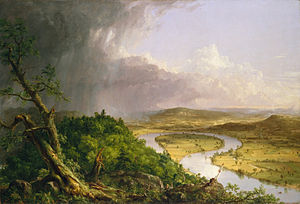All AP Art History Resources
Example Questions
Example Question #331 : 2 D Art

The painting depicts members of the family and court of what ruler?
King George III
King Philip IV of Spain
Mary Queen of Scots
Queen Elizabeth I
William and Mary
King Philip IV of Spain
The painting is Las Meninas by Velasquez, and was painted in 1656 during the Spanish Golden Age during King Philip's reign. It depicts his the young Infanta Margaret Theresa, several ladies in waiting, dwarfs, and Velasquez himself.
Image is in the public domain, accessed through WikiArt: http://www.wikiart.org/en/diego-velazquez/las-meninas-detail-of-the-lower-half-depicting-the-family-of-philip-iv-of-spain-1656
Example Question #27 : Answering Other Questions About Nineteenth Century 2 D Art

http://www.wikiart.org/en/diego-velazquez/las-meninas-detail-of-the-lower-half-depicting-the-family-of-philip-iv-of-spain-1656
Whose view do we take on when looking at this painting?
The dog
The King and Queen
The Spanish people
Velasquez
The Infanta
The King and Queen
We are looking at the scene from the perspective of an outsider, and a famous detail of the painting is the reflection of the King and Queen in the mirror at the back of the room. Thus, our view is actually that of the King's, taking in the way Velasquez is painting his family.
Image is in the public domain, accessed through WikiArt: http://www.wikiart.org/en/diego-velazquez/las-meninas-detail-of-the-lower-half-depicting-the-family-of-philip-iv-of-spain-1656
Example Question #333 : 2 D Art
What artist's Jug in the Form of a Head sculpture, which is missing an ear, is believed to be inspired by his traumatic relationship with Van Gogh?
Matisse
Degas
Gauguin
Renoir
Cezanne
Gauguin
The sculpture is a reflection of Gaugin's uneasy relationship with Van Gogh. The two became friends when Van Gogh and his brother purchased several of Gaugin's paintings. They went on to work together for nine weeks at Vincent's Yellow House, during which time their friendship cooled. The night Van Gogh cut his ear off, the artist had earlier confronted Gaugin with a razor blade. The sculpture shows Gaugin's ear cut off as a reference to his former friend.
Example Question #28 : Answering Other Questions About Nineteenth Century 2 D Art

The work shown here was closely related in ideals and philosophical backing to the intellectual movement known as __________________.
Transcendentalism
Calvinism
Positivism
Neoplatonism
Transcendentalism
Thomas Cole and other Hudson River School artists desired to show the way that God's creation of nature was a sublime gift that should be held in awe, a sense shared by transcendentalist authors such as Ralph Waldo Emerson and Henry David Thoreau. In The Oxbow (View From Mount Holyoke, Northampton, Massachusetts, after a Thunderstorm), Cole presents a thunderstorm coming over a picturesque scene of a New England town, enhancing nature's awesome power over humanity.
Artwork from Wikimedia Commons: https://commons.wikimedia.org/wiki/File:Cole_Thomas_The_Oxbow_(The_Connecticut_River_near_Northampton_1836).jpg
Example Question #29 : Answering Other Questions About Nineteenth Century 2 D Art

The Oxbow (View From Mount Holyoke, Northampton, Massachusetts, after a Thunderstorm), by Thomas Cole, was most significantly influenced by _______________.
Realism
Romanticism
Neoclassicism
the Grand Manner
Romanticism
Thomas Cole and his followers in the Hudson River School were keen adherents to the ideals of Romanticism, which valued individual liberty, nature, and emotionalism. In The Oxbow (View From Mount Holyoke, Northampton, Massachusetts, after a Thunderstorm), a wild landscape is presented with an oncoming storm hitting the small glimpse of civilization shown in the painting, echoing key themes of Romanticism.
Artwork from Wikimedia Commons: https://commons.wikimedia.org/wiki/File:Cole_Thomas_The_Oxbow_(The_Connecticut_River_near_Northampton_1836).jpg
Example Question #1 : Twentieth And Twenty First Century 2 D Art
Pablo Picasso took direct inspiration from all of the following artists EXCEPT __________.
Wassily Kandinsky
Diego Velázquez
El Greco
Henri Matisse
Wassily Kandinsky
Pablo Picasso emerged in the early years of the the twentieth century from Spain being clearly influenced by his Spanish antecedents Diego Velázquez, El Greco, and Francisco de Goya. When he moved to Paris in 1901, he began to be influenced, and helped shape the careers of, fellow artists like Henri Matisse and Georges Braque. After the 1930s, however, while Picasso himself was massively influential, he began to retreat into his own style and missed out on innovations by painters like Wassily Kandinsky.
Example Question #332 : 2 D Art

The above work of art is a representative of the movement known as __________.
Impressionism
De Stijl
Bauhaus
Surrealism
De Stijl
The De Stijl movement grew out of the work of a select group of Dutch modernists in the 1890s, who all focused on basic shapes and form over function in design. Piet Mondrian, whose Tableau I is displayed here, was the foremost painter of the De Stijl movement. Mondrian's chief visual markers—primary colors, simple geometric forms, and thick black lines—are all hallmarks of the De Stijl movement more generally.
Image: Tableau I by Piet Mondrian (1921)
Example Question #333 : 2 D Art

The artist of the above work was hugely influential to __________.
Neorealism
Surrealism
Pop Art
Abstract Expressionism
Abstract Expressionism
Mondrian's use of geometric shapes and simple lines gave him the opportunity to create abstract art that nonetheless borrowed from familiar forms. The abstract expressionists, who flourished in the two decades after World War II in New York City, similarly used bold expressions of color and shapes to create abstract forms. Many of the abstract expressionists, most notably Mark Rothko, similarly used large blocks of color on sizable canvasses.
Image: Tableau I by Piet Mondrian (1921)
Example Question #334 : 2 D Art

The artistic style belonging to this artist is distinguished by all of the following EXCEPT __________.
wide use of squares and rectangles
wide use of primary colors
thick black lines running across the canvas
wide use of abstract shapes
wide use of abstract shapes
While Piet Mondrian, the creator of this painting, is well known as an abstract artist, he actually used essentially no abstract shapes in his paintings. Instead, Mondrian placed together thick black lines to create geometrical patterns, almost entirely in squares and rectangles, and then used large blocks of primary colors to create different images.
Image: Tableau I by Piet Mondrian (1921)
Example Question #335 : 2 D Art

This painting was highly influenced by __________.
the Christian religion
classic literature
advanced mathematics
scientific discoveries
advanced mathematics
As an example of cubism, this painting deeply engages with various forms of advanced mathematics, especially geometry. Cubism broke down forms to various geometric shapes, and rendered them in crystalline forms based on those shapes. Cubism could be taken to different lengths; certain works may have a difficult underlying shape to discern, but Gris' Portrait of Pablo Picasso surrounds a rather conventional human form with geometric shapes.
Figure: Portrait of Pablo Picasso by Juan Gris (1912)
All AP Art History Resources




